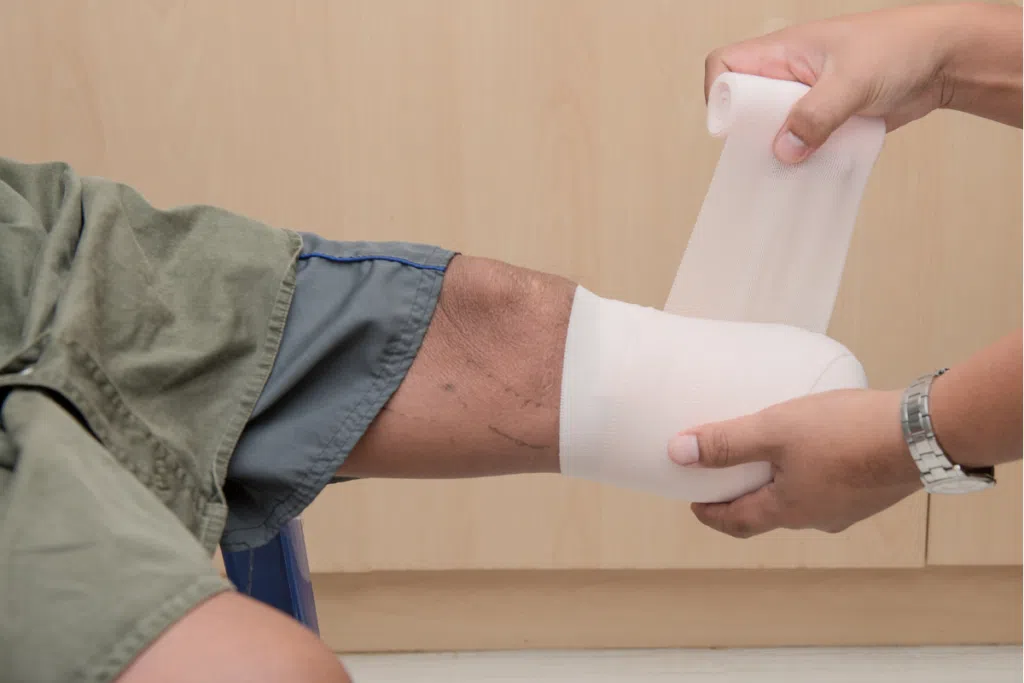Chicago Amputation Lawyer
Amputation is the loss of a limb or part of a limb. It can occur for a variety of reasons, with the most common causes being major injuries, diabetes, and vascular disease. Amputations can lead to a variety of complications. The lifetime medical cost of an amputation is estimated to be over $500,000. Levin & Perconti can help you recover damages to pay for medical treatment and other injury-related expenses.
Amputation is the loss of a limb or a part of a limb. In the United States, about 185,000 amputations are performed each year. There are many different types of amputations, ranging from the loss of a fingertip to the loss of a whole leg (or even both legs).
Regardless of the type, amputation is a traumatic event and can lead to a variety of complications. If you’ve experienced an amputation due to someone else’s negligence, one of the skilled and compassionate personal injury lawyers at Levin & Perconti can help.
Types of Amputation
In general, amputations are classified by which specific limb, or part of a limb, is lost. The major types include:
- Lower limb amputation. This involves the loss of a toe, foot, lower leg, or entire leg. In some cases, part of the pelvis may even be lost.
- Upper limb amputation. This involves the loss of a finger, hand, lower arm, or entire arm. In some cases, the shoulder blade may even be lost.
Lower limb amputations are significantly more common than upper limb amputations. Approximately 150,000 people undergo a lower limb amputation in the United States every year. The most common type involves the loss of a toe, but a significant proportion of amputations involve the loss of the whole foot or the whole lower leg.

Causes of Amputation
There are a variety of reasons that someone may lose a limb. Some of the possibilities include:
- Injuries. For example, car accidents are a common cause of amputation. Work-related accidents involving sharp tools or heavy machinery are another common cause, particularly when safety protocols are not followed properly. Combat-related injuries are another common cause.
- Medical Negligence. Acts or omissions that deviates from medical standards may lead to preventable amputations. Medical malpractice can include misdiagnosis, delayed diagnosis, surgical errors, and medical device errors, and medication errors.
- Peripheral arterial disease (PAD). This is a condition in which blood flow through the arteries in the legs is reduced. If there’s not enough blood flow, then tissues may die off, requiring an amputation. PAD is commonly caused by atherosclerosis, a condition in which cholesterol deposits form in the walls of arteries, causing them to become stiff and narrow. Conditions like high cholesterol and smoking raise the risk of this condition.
- Diabetes. People with diabetes are at a higher risk for PAD. High blood sugar levels cause damage to small blood vessels throughout the body, including those in the feet. Lack of blood flow can cause tissues to die off and can make it difficult for any wounds to heal. High blood sugar can also cause damage to the nerves. This can allow a small injury to go unnoticed, and it can become a serious infection.
- Tumors. Although relatively rare, certain types of cancers can lead to the need for amputation of the affected limb. These include sarcomas, which form in the bone or other soft tissues.
- Severe infections. When an infection extends into the bloodstream, this is known as sepsis. It can reduce blood flow in the limbs and may cause tissue to die, requiring amputation.
According to Johns Hopkins Medicine, injuries cause about 45 percent of amputations, while about 54 percent are caused by diabetes or other causes of peripheral arterial disease.
Complications of Amputation
After an amputation, a person may suffer from a variety of complications.
- Infections
- An infection that develops at the surgical site may extend deeply into tissues, leading to a serious or even life-threatening infection. This may lead to an additional amputation procedure to remove the infected tissue. Nearly 30 percent of patients with a post-amputation infection die within a month.
- Edema, or swelling
- There may be significant swelling in the stump months or even years after the amputation. This can interfere with the use of prosthetics and can be uncomfortable. Proper surgical technique greatly decreases the risk of significant ongoing edema.
- Phantom limb pain
- This is a neurological condition in which people feel pain or other sensations that seem to originate from a missing limb. Phantom limb pain affects most people who have experienced an amputation and often significantly affects their quality of life. This condition can be very challenging to treat.
- Residual limb pain
- This is pain at the site of the amputation, also known as “stump pain.” It differs from phantom limb pain, which is felt in the missing part of the limb rather than in the part that remains. Residual limb pain can result from skin breakdown, nerve damage, infections, or changes in blood flow. Poor surgical technique during the amputation may increase the risk of residual limb pain.
- Contracture
- This occurs when soft tissues near the site of amputation gradually shorten and tighten, which can restrict the movement of the nearby joint. Proper post-surgical care is important to decrease the risk of contracture.
- Muscle weakness
- Changes in the way the body moves after an amputation can cause some muscles to become weak. This may increase the risk of a fall, which can lead to additional injury. It’s important that the patient receive appropriate rehabilitation after their amputation to help address this issue.
- Mental health challenges
- No matter the cause, the loss of a limb is always a traumatic event. Studies suggest that “between 15% and 26% of individuals with limb loss might experience PTSD.” More than 70 percent of people experience depression, and up to 30 percent may have suicidal impulses in the wake of this event. It’s important for anyone who has experienced an amputation to receive mental health support.
Costs Associated With Amputation
A study published in the Journal of Bone & Joint Surgery investigated the costs associated with amputations. The study found that the short-term medical costs for a lower-limb amputation, including the costs of a prosthetic limb, were over $90,000. The lifetime medical costs for this injury were found to be over $500,000.
It’s worth noting that the same study found that the lifetime costs for limb reconstruction were approximately $160,000. After a major injury, medical teams may need to choose between reconstructing a limb and amputating it. If a team chooses amputation when reconstruction would have been possible, this choice will greatly increase the patient’s lifetime medical costs as well as the patient’s distress.
Trust Levin & Perconti’s Amputation Lawyers

In some cases, a person may suffer an amputation as a result of someone else’s negligence. For example, a car crash caused by another driver could lead to the loss of a limb. A workplace could fail to follow proper procedures to ensure the safety of its workers, leading to a major injury. Medical negligence could lead to the worsening of a medical condition that later requires an amputation.
Amputation is an irreversible and life-altering event with a high financial as well as emotional cost. If you’ve suffered from the loss of a limb due to someone else’s negligence, then you deserve justice. You should be compensated for all of your medical costs and lost wages, as well as the loss of quality of life.
We have successfully represented clients who have endured amputation and we’re ready to fight just as hard for you. After many years of litigating personal injury and medical malpractice cases, we know what it takes to win justice for our clients.
If you’re looking for a Chicago amputation lawyer, please contact us for a free case review.
$1.25 Million
Settlement
for a 77-year-old woman whose right leg was amputated above the knee when she was struck by a bus while walking across a bus terminal.
$4.5 Million
Settlement
for a deckhand whose leg was crushed between two barges resulting in an above the knee amputation.
Testimonials
Not only were they so professional but also so caring and thoughtful. It was very difficult going over the facts in our mother's case but they were so compassionate and understanding and allowed us to be with them every step of the way. We were able to sit in on the depositions and we were really able to see how hard they worked on our behalf.
During that time, my family and I suffered the loss of my mother. Mr. Levin and Mr. Perconti were more than just our lawyers. Words can’t really express our gratitude.
They were most patient and responded timely to many questions throughout the entire process. All demonstrated professionalism and extensive knowledge of case and state laws. Their in-depth investigative work uncovered details which were unknown to us and yet sadly confirmed our suspicions. We would recommend the Levin and Perconti Law firm and especially this team.
During that time, my family and I suffered the loss of my mother. Mr. Levin and Mr. Peconti were more than just our lawyers. Words can’t really express our gratitude. My family and I will always be grateful for the compassion that they showed us. I want to thank you for what you did for my family, and for always being there for us.
Margaret’s representation, guidance, and professionalism gave us the sense that we could put our trust in Levin & Perconti and the final outcome proved that to be true.
Legally Reviewed by

Jaime Koziol Delaney
Contact Us
- Free Consultation
- (312) 332-2872
"*" indicates required fields
Notable Results
Settlement
for the families of 6 children who died in a tragic apartment fire on Chicago’s north side
Settlement
for the mother of a young man who suffered a fatal brain injury after falling from the porch of a second story Chicago apartment
Settlement
for the family of an 88-year-old man Chicago man who died after suffering serious injuries in a fall at a Jiffy Lube service center
Our Office
325 N LaSalle Dr Suite 300
Chicago, IL 60654
312-332-2872